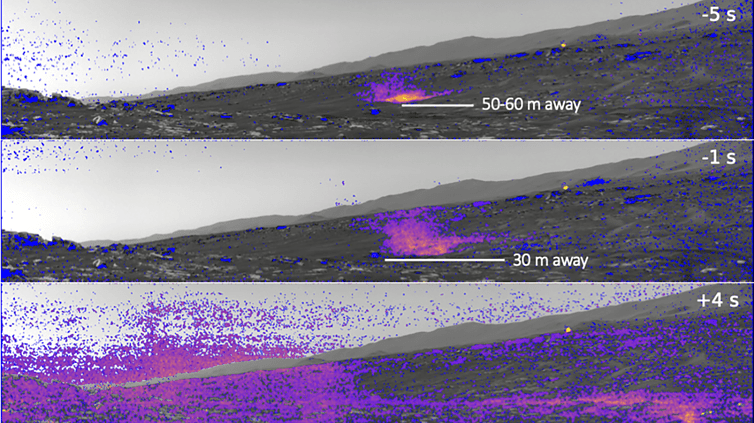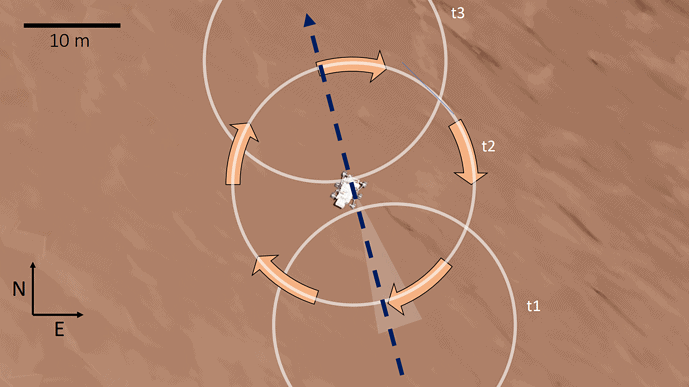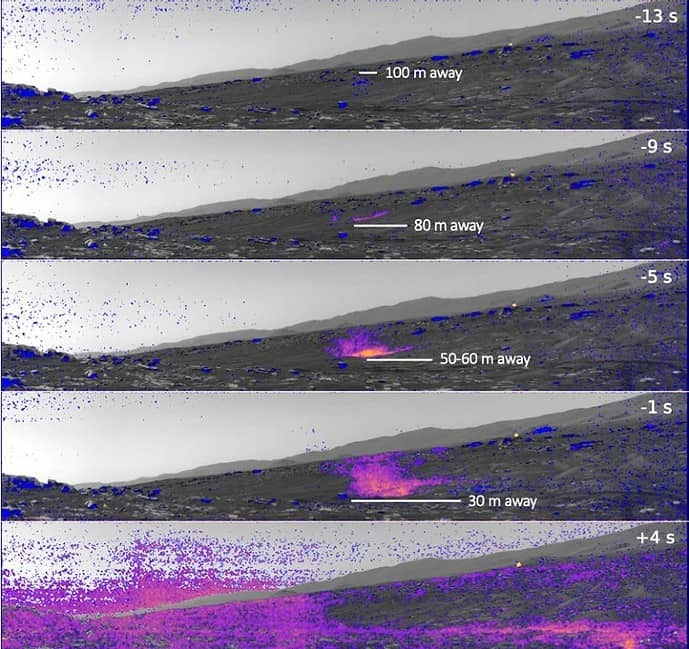
15.12.2022
Researchers accidently catch first ever sound recording of dust devils on Mars

Images taken by NASA’s Perseverance rover record a Martian dust devil’s approach and arrival. Blue indicates the highest dust content, yellow the lowest. Credit: NASA/JPL-Caltech/Space Science Institute/ISAE-SUPAERO
From the cold, barren deserts of Mars, photos are now a regularity thanks to rovers and satellites combing the planet. Rarely though do we get to listen to the sounds of the Martian world.
A new study published in Nature Communications has used the Perseverance rover’s SuperCam to allow us a very brief insight into the sounds of Mars, with the first ever sound recording of a dust devil on the red planet.
“We can learn a lot more using sound than we can with some of the other tools,” said Professor Roger Wiens, a Purdue University planetary scientist, and the principal investigator of the SuperCam.

“They take readings at regular intervals. The microphone lets us sample, not quite at the speed of sound, but nearly 100,000 times a second. It helps us get a stronger sense of what Mars is like.”
Dust devils, often called “willy-willies” in most parts of Australia and “whirly-whirly” in Queensland, are whirlwinds of dust and grit that occur on both Mars and Earth. While Earth dust devils can make it to 300 metres tall, Mars dust devils can reach lofty heights of 8 kilometres.
It was mostly luck that the team managed to get the recoding, as the microphone on Perseverance only records about three minutes of audio every few days. The team calls this ‘a chance encounter’. But so far, the team has evidence of nearly 100 dust devils since the rover landed in February 2021, so it was likely a matter of time.

Perseverance records pictures much more frequently, so the team was able to see and hear the dust devil at the same time.
“The dust devil encounter was also simultaneously imaged by the Perseverance rover’s Navigation Camera and observed by several sensors in the Mars Environmental Dynamics Analyzer instrument,” the team wrote in it’s new paper.
“Combining these unique multi-sensorial data with modelling, we show that the dust devil was around 25 metres large (stet), at least 118 metres tall, and passed directly over the rover travelling at approximately 5 metres per second.”
The microphone on the rover also picked up the sound of being hit by a total of 308 dust grains . The researchers then calculated that the maximum concentration of dust in the vortex to be 27 particles per metre, which is not a lot. The area of Mars where Perseverance is rolling around doesn’t seem to be a very windy place.
You can listen to what this sounded like below:
“We could watch the pressure drop, listen to the wind, then have a little bit of silence that is the eye of the tiny storm, and then hear the wind again and watch the pressure rise,” Wiens said.
“The wind is fast — about 25 miles per hour, but about what you would see in a dust devil on Earth. The difference is that the air pressure on Mars is so much lower that the winds, while just as fast, push with about 1% of the pressure the same speed of wind would have back on Earth.
“It’s not a powerful wind, but clearly enough to loft particles of grit into the air to make a dust devil.”
This means that these dust devils are unlikely to knock over equipment any equipment astronauts bring to Mars, but it has been suggested that it has helped blow the dust off solar panels of rovers such as Opportunity and Spirit. “Those rover teams would see a slow decline in power over a number of days to weeks, then a jump. That was when wind cleared off the solar panels,” Wiens said.
Originally published by Cosmos as Scientists uncover the sounds of Mars
Quelle: COSMOS
1024 Views
